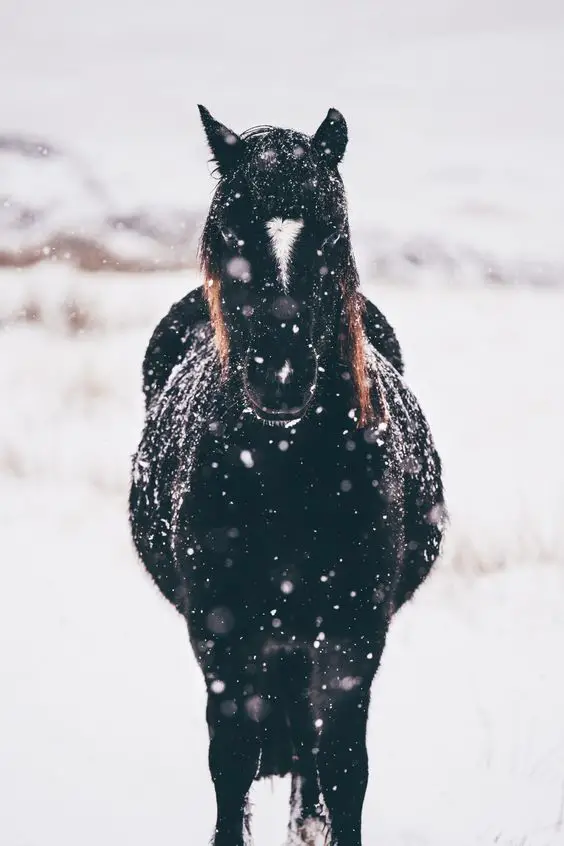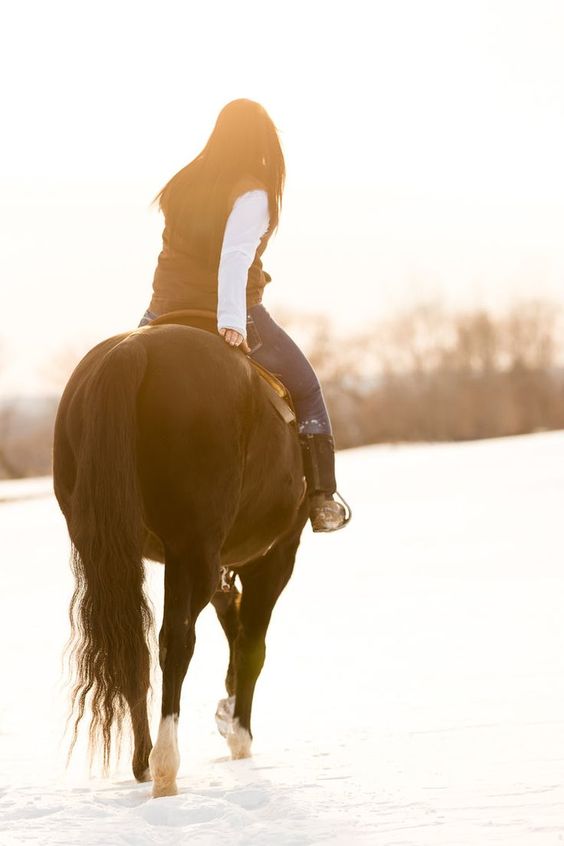Winter is a great time for horseback riding. Fresh frosty air, the absence of annoying insects – all this is very useful. Such walks are very useful not only for your health but also for strengthening your pet’s immunity.
However, at this time, you need to take into account some of the nuances of caring for the animal and the ride itself. This is what this article is about.
Winter Horseback Riding

It is best for a horse in winter if the snow cover is several centimeters thick and there is no ice crust underneath.
Snow gives an additional load on the muscular and cardiovascular system of the animal, training both.
And even a canter is not required for a good workout. A lynx in the snow is enough. Winter riding should take place on a well-known surface, studied even in the warm season.
The snow cover hides pits and potholes, and this is fraught with injury to the animal. Be careful.
It is undesirable for horses to run on hard frozen ground in winter, as this is harmful to their legs. A slippery and wet snow surface is no less dangerous.
Even with studded horseshoes, the horse can slip.
After a horse run in cold winter, before taking the animal to the stall, you need to walk it with a step to allow it to cool.
Moreover, horses with a long winter coat take more time to do this than horses with short hair and covered with blankets.
Winter Care

At this time of the year, you need to carefully monitor the condition of the coat.
The horse needs to be brushed and brushed regularly to avoid clogging the pores on the skin, which negatively affects the sweating and heat conservation of the animal.
Grooming is necessary whether you cover your horse with a blanket or not.
Dust and dirt also accumulate under it.
Use a soft brush for daily care. This makes it possible not only to remove particles of dirt and dust but also has a beneficial effect on blood circulation.
More thorough cleaning is also needed periodically. To do this, the horse must first be cleaned with a scraper and then walked over the coat with a damp brush. At the end of the procedure, do not forget to dry the animal with a towel or piece of clean and dry cloth.
Many people mistakenly believe that when using blankets in winter, careful care can be neglected. This is a dangerous delusion since particles of dirt and dust accumulate well under the blanket.
Therefore, before and after each trip, you should definitely go over the skin with a brush. In addition, during cleaning, scuffs, and other damage become noticeable, which must be treated promptly.
If the weather in your region is not conducive to horse riding in the fresh air, daily grooming is an extra opportunity to be with your pet. A horse is an animal with a very sensitive nervous system, and she will definitely appreciate such attention from your side.
In winter, you also need to carefully monitor the condition of the hooves. Inspect them daily before and after riding.
Keeping these animals in cramped stalls all the time is harmful. Try to use every opportunity to walk your pet in the fresh air.
Constant tightness in a stall can make a horse irritable and angry. The more she is on the street, the better her emotional and physical condition will be.
It is especially dangerous to take a horse out onto an icy surface, even with studded horseshoes.
If the horse is forced to be in the stable for a long time, try to pay more attention to it. You can increase your daily hay supply to give your horse something to do.
However, do not give a huge armful at once. It is better to divide it into several reasonable parts and give it throughout the day.
If the temperature permits, try to keep the stable door open. This will provide fresh air and good lighting. Many experts recommend taking a radio to the stable. Most horses respond well to music and human voices.
Winter Problems
In winter, people often get sick. And although horses practically do not catch colds, they also have their own sores associated with low temperatures. Remember that you need to take good care of your animal throughout the year, and then most of the winter problems can be avoided.
Winter Blues
In winter, the behavior of these animals tends to change. Any horse in the winter can be very depressed. The tightness of the stall leads to the fact that he begins to entertain himself. At the same time, bad habits often appear.
The animal gnaws at the wooden parts of the stall, hits everything it can reach with its hoof, begins to swing from side to side. Common and airy bites are bad habits.
The first is characterized by the fact that the horse grasps the stall door, post, or partition with its teeth then strains the neck muscles, sucks in the larynx, and swallows air. With an air bite, the horse swallows air and “grunts” without catching objects with his teeth.
These vicious habits often lead to tooth wear or gassing colic. To avoid the horse blues, try to walk with the animal more. If this is not possible, keep him busy – toys, personal communication, music, hay, and so on.
Colic
Horses often have colic in the cold winter season. These animals are very demanding of drinking water and, if it is too cold, they will not drink it. Lack of drinking leads to blockage of the intestinal passage with food, which provokes colic. In peak cases, surgery may even be required.
Active walks and a normal horse drinking temperature help to avoid this problem.
Respiratory Diseases
In winter, some animals are prone to chronic obstructive pulmonary disease. Its main causes are moldy damp hay, dust in the ambient air, and poor ventilation.
Symptoms range from mild wheezing to severe coughing. In some cases, a nasal discharge may appear.
Prevention – good ventilation, high-quality feed, clean and dry stables, and clean-cut paper mat. If the animal does get sick, a qualified veterinarian will prescribe treatment.
Winter Injuries
The risk of injury at this time of the year is increased. Slippery ground surface, reduced physical activity, low ambient temperature – all this weakens the bones and muscles of the animal. Hard crust and ice can also damage a horse’s legs if not properly “shod”.
In winter, studded horseshoes are usually used to improve traction, although some horse breeders do without horseshoes at all, believing that in winter the horse stands better on the surface.
Snow often clogs in the hooves, so it is recommended to lubricate the horse’s soles with petroleum jelly. It is important to make sure the animal moves on the level, familiar ground.
Animals with arthritis are most at risk of injury in winter. To minimize this likelihood, try to walk the animal in the fresh air more often. The more the horse moves, the stronger its muscles and skeleton and the more stable the immune system.
